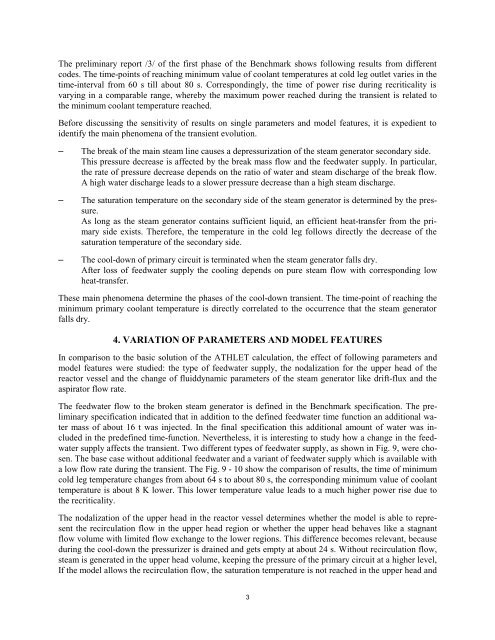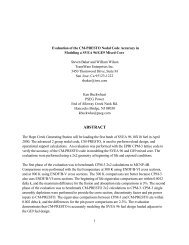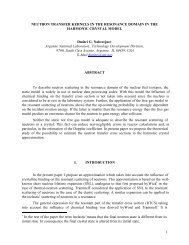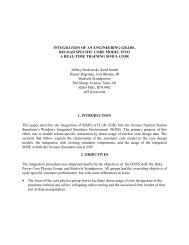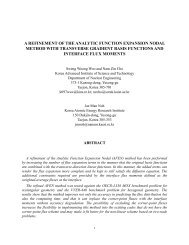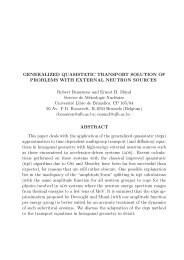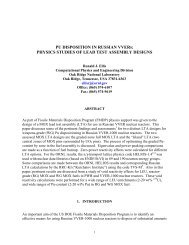S. Langenbuch, K.-D. Schmidt, and K. Velkov
S. Langenbuch, K.-D. Schmidt, and K. Velkov
S. Langenbuch, K.-D. Schmidt, and K. Velkov
Create successful ePaper yourself
Turn your PDF publications into a flip-book with our unique Google optimized e-Paper software.
The preliminary report /3/ of the first phase of the Benchmark shows following results from different<br />
codes. The time-points of reaching minimum value of coolant temperatures at cold leg outlet varies in the<br />
time-interval from 60 s till about 80 s. Correspondingly, the time of power rise during recriticality is<br />
varying in a comparable range, whereby the maximum power reached during the transient is related to<br />
the minimum coolant temperature reached.<br />
Before discussing the sensitivity of results on single parameters <strong>and</strong> model features, it is expedient to<br />
identify the main phenomena of the transient evolution.<br />
– The break of the main steam line causes a depressurization of the steam generator secondary side.<br />
This pressure decrease is affected by the break mass flow <strong>and</strong> the feedwater supply. In particular,<br />
the rate of pressure decrease depends on the ratio of water <strong>and</strong> steam discharge of the break flow.<br />
A high water discharge leads to a slower pressure decrease than a high steam discharge.<br />
– The saturation temperature on the secondary side of the steam generator is determined by the pressure.<br />
As long as the steam generator contains sufficient liquid, an efficient heat-transfer from the primary<br />
side exists. Therefore, the temperature in the cold leg follows directly the decrease of the<br />
saturation temperature of the secondary side.<br />
– The cool-down of primary circuit is terminated when the steam generator falls dry.<br />
After loss of feedwater supply the cooling depends on pure steam flow with corresponding low<br />
heat-transfer.<br />
These main phenomena determine the phases of the cool-down transient. The time-point of reaching the<br />
minimum primary coolant temperature is directly correlated to the occurrence that the steam generator<br />
falls dry.<br />
4. VARIATION OF PARAMETERS AND MODEL FEATURES<br />
In comparison to the basic solution of the ATHLET calculation, the effect of following parameters <strong>and</strong><br />
model features were studied: the type of feedwater supply, the nodalization for the upper head of the<br />
reactor vessel <strong>and</strong> the change of fluiddynamic parameters of the steam generator like drift-flux <strong>and</strong> the<br />
aspirator flow rate.<br />
The feedwater flow to the broken steam generator is defined in the Benchmark specification. The preliminary<br />
specification indicated that in addition to the defined feedwater time function an additional water<br />
mass of about 16 t was injected. In the final specification this additional amount of water was included<br />
in the predefined time-function. Nevertheless, it is interesting to study how a change in the feedwater<br />
supply affects the transient. Two different types of feedwater supply, as shown in Fig. 9, were chosen.<br />
The base case without additional feedwater <strong>and</strong> a variant of feedwater supply which is available with<br />
a low flow rate during the transient. The Fig. 9 - 10 show the comparison of results, the time of minimum<br />
cold leg temperature changes from about 64 s to about 80 s, the corresponding minimum value of coolant<br />
temperature is about 8 K lower. This lower temperature value leads to a much higher power rise due to<br />
the recriticality.<br />
The nodalization of the upper head in the reactor vessel determines whether the model is able to represent<br />
the recirculation flow in the upper head region or whether the upper head behaves like a stagnant<br />
flow volume with limited flow exchange to the lower regions. This difference becomes relevant, because<br />
during the cool-down the pressurizer is drained <strong>and</strong> gets empty at about 24 s. Without recirculation flow,<br />
steam is generated in the upper head volume, keeping the pressure of the primary circuit at a higher level,<br />
If the model allows the recirculation flow, the saturation temperature is not reached in the upper head <strong>and</strong><br />
3


